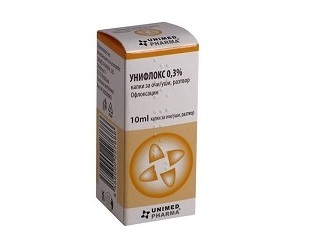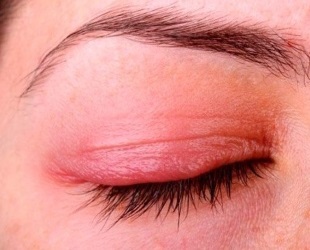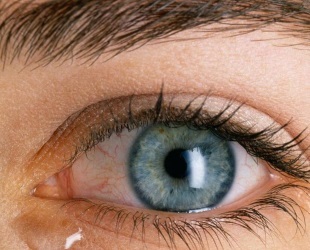
Eyes are very tender and vulnerable organs, so they often suffer from infection.
For the treatment of diseases of an infectious nature, ophthalmologists recommend to their patients various drugs, the most common of which are drops.
Uniflox is a medicinal product with antibacterial effect.
Its main active ingredient is ofloxacin, which belongs to the antibiotics of the fluoroquinolone group.
Uniflox is widely used in ophthalmic and otological practice for the treatment of various ailments of bacterial origin.
- 1. Instructions for use
- 2. Side effects of
- 3. Storage terms and conditions
- 4. Price
- 5. Analogues
- 6. Reviews
- 7. Conclusion
Instruction for use
Useful action
Mechanism of actionis based on the property of ofloxacin to inhibit the activity of DNA-topoisomerase II type, as a result of which DNA replication of microorganisms fails.
Ofloxacin is active against strains of Gram-negative and Gram-positive microorganisms, as well as bacteria exhibiting resistance to methicillin and penicillin.
The main advantage of Uniflox over other topical antibiotics is that it is perfectly absorbed into the anterior eye chamber and cornea.
Even after four hours after using this drug, its concentration in the organs of vision is quite effective.
Indications for use

In ophthalmology Uniflox is used to get rid of the following bacterial infections of the anterior segment of the eye that were provoked by the susceptible to ofloxacin bacteria:
- Keratitis.
- Conjunctivitis of infectious nature.
- Blepharitis.
- Keratoconjunctivitis.
- Dacryocystitis.
- Blepharoconjunctivitis.
- Barley.
- Halyazion.
- Ulcerous lesion of the corneal region.
- Endophthalmitis( as part of complex treatment).
Uniflox can be used for the prevention of eye damage, after removing foreign bodies from the eyes and performing operations, as well as during preparation for them.
In otology, Uniflox is used to treat various types of otitis media and is used as a prophylactic for surgical interventions.
Form release
| Form | Drops for eye and ear concentrations 0,3% |
| Volume | Vial dropper 5 ml |
| Composition per 1 milliliter of preparation |
|
Manufacturer: UNIMED PHARMA Ltd. Production address: Orieskova str., 11 821 05, Bratislava, Slovak Republic.
Method of administration and dosage
This preparation is intended for insertion into the conjunctival bag or external ear passage. When using it, avoid touching the tip of the dropper with eyelashes, skin and mucous membranes.

After each instillation the bottle must be carefully screwed.
For the treatment of eye diseases Uniflox should be instilled in a bag of conjunctiva, slightly bending the head back and holding the bottle to the top of the bottom.
Persons over the age of twelve years in most cases are prescribed one or two drops of this drug every hour during the first two days of the therapeutic course.
After this, the dose is reduced until one or two drops are administered six to eight times a day. After two or three days the patient should go to a stabilizing dose, which physicians determine individually for each specific case.
The duration of the therapeutic course usually ranges from one to two weeks. Once the purulent discharge from the eyes stops, Uniflox should be used for at least three more days. More than two weeks to use this medication is not recommended.

Children from three to twelve years in most cases are prescribed one drop of Uniflox five times a day, and the duration of the course of therapy should not exceed one week.
For the treatment of otological diseases Uniflox is placed in the external ear canal.
The patient needs to lie on his side during the instillation of the drug, and also for five minutes after it. To avoid dizziness, the drops should be heated to body temperature before use.
Patients over the age of twelve are usually prescribed ten drops every twelve hours. The duration of the therapeutic course with otitis external type is usually ten days, and with chronic purulent otitis - two weeks.
Persons aged three to twelve years are often prescribed five drops of Uniflox with a break of twelve hours, and the duration of therapy is ten days.
Interaction with other medications
When using Uniflox with other medications for local use, you must adhere to the gap for at least fifteen minutes.
Drugs containing magnesium, iron, zinc and aluminum can degrade the absorption of ofloxacin. If the patient uses contact lenses, they should be removed half an hour before using Uniflox, and after half an hour after instillation of this drug, the lens can be installed back.
During the therapy, the lens needs to be further purified by special means to avoid re-infection.
The use of Uniflox with macrolides, antiarrhythmic drugs of class IA and III, antipsychotic agents and tricyclic antidepressants should not be combined.
Side effects of
When Uniflox is injected into the eyes, slight burning and redness of the conjunctiva can be observed, and when using these drops to relieve otitis, bitterness and itching occur.
Sometimes, people may experience such adverse reactions :

- allergic reactions;
- edematous vision;
- photophobia;
- keratitis;
- a feeling of discomfort in the eyes;
- conjunctivitis;
- periorbital edema;
- increased lacrimal fluid separation;
- sensation of foreign body in the eyes;
- itching in the eyelid;
- feeling of nausea;
- drying of eyes;
- pain in the field of vision;
- facial swelling;
- ventricular arrhythmia;
- paroxysmal ventricular tachycardia of pirouette type;
- eczema;
- paresthesia;
- pain or tinnitus;
- dry mouth;
- dizziness.
Contraindications
Uniflox should not be used in the following cases:
- Intolerance of ofloxacin and other substances from the fluoroquinolones group.
- Chronic conjunctivitis of noninfectious genesis.
- Infectious diseases caused by ofloxacin-resistant organisms.
- Treatment of patients younger than three years.
In pregnancy,
Uniflox can be prescribed to women bearing a child only if the benefits of using it significantly exceed the risk of using it.
Do you think that you have become worse to see? Do not know how to put in your eyes or cure such a common disease, like barley? We bring to your attention the following articles:
- How correctly to instill drops into the eyes?
- Vision check online
- How to cure barley at home?
Terms and Conditions of Storage
Uniflox droplets should be stored in rooms where the air temperature does not rise above 25 degrees Celsius, within two years from the date of their manufacture.
This drug should not be frozen. Since the printing of the bottle, drops should be used for four weeks.
Price
Average price in Russia
The cost of drops of Uniflox in Russian pharmacies today varies within 100 rubles .
Average cost in Ukraine
Residents of Ukraine currently can purchase the described drug in their country's pharmacies approximately for 70 hryvnia .
Analogues
For preparations that can be called Uniflox analogues, it is necessary to refer:
- Ciprofloxacin;
- Tsiprolet;
- Levofloxacin;
- Digital;
- Levomycetin;
- Stillavit;
- Maxitrol;
- Oftan Timogel;
- Norfloxacin.
Reviews
Uniflox drops boast a huge amount of positive feedback from grateful patients who note the high efficiency of this tool in both ophthalmology and otology.
The main advantages of these drops are the possibility of their use for the treatment of children, ease of use, minimal side effects and speed.
The disadvantage of Uniflox was that patients named a short shelf life, but this feature is characteristic of most similar drugs.
If you want to see more detailed reviews of these drops, you can find them at the end of the article.
Conclusion
- Uniflox is an antibacterial drug whose main active ingredient is ofloxacin.
- It can be found on sale in the form of ear and eye drops.
- Uniflox is used to treat a number of infectious diseases.
- There are certain contraindications to the use of this drug.
- Sometimes using Uniflox can cause side reactions.
- If necessary, Uniflox can be replaced with a similar medicine.
- Uniflox drops have an excellent reputation.
